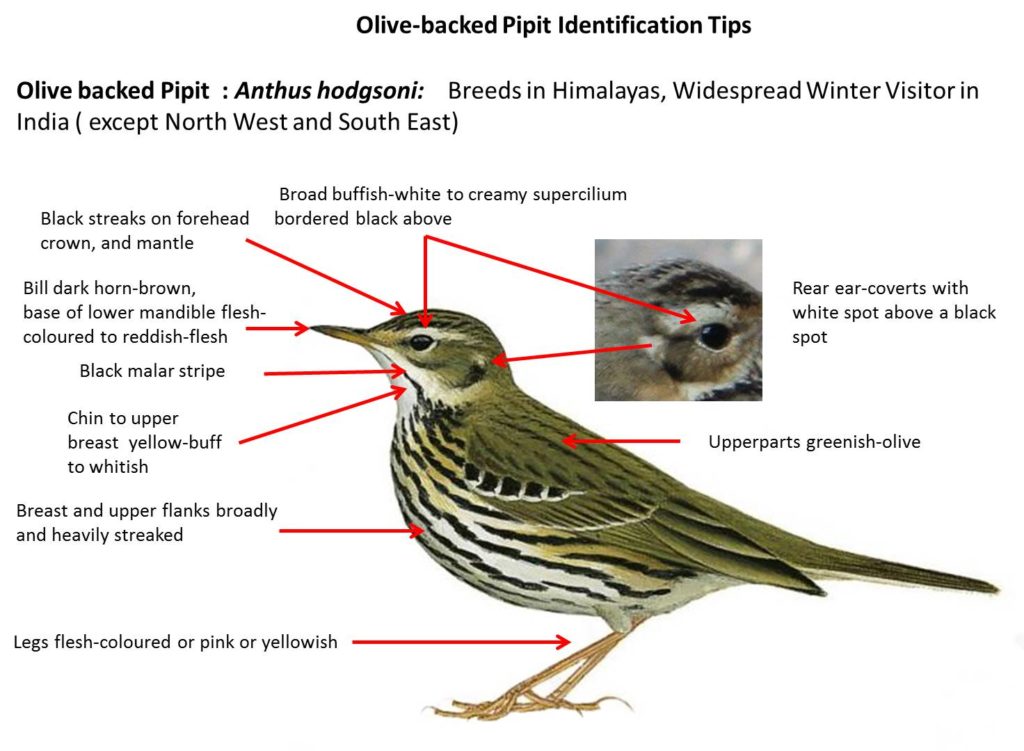Olive-backed Pipit

Olive-backed Pipit Anthus hodgsoni
Etymology:
- Anthus : Based on Greek mythology. Anthus, son of Antinous and Hippodamia, was killed by his father’s horses and metamorphosed into a bird which imitated the neighing of horses but fled at their sight
- Hodgsonii :Named after English diplomat Brian Houghton Hodgson (1800–1894)
Vernacular Names: Hindi: Musarichi, Pun: Rukhcharchari, Ben: Muchassi, Lilashvalidhanchidi, Munda: Ambal-serwi, Guj: Dhanchidi, Ta: Pulkuruvi, Te: Likujitta, Mar: ShevaliPathichiTirchimany
Distribution in India: Breeds in Himalayas, winter visitor all over India except South East and North West.
Description:Size of 15–17 cm; wt. of 17–26·3 g. The nominate race has broad buffish-white to creamy supercilium bordered black above, rear ear-coverts have white spot above a black spot; black malar stripe; upperparts are greenish-olive, with prominent black streaks on forehead and crown, and black streaks on mantle; lesser wing-coverts are greenish-olive, other wing feathers are blackish, edged greenish or yellowish, the greater and median coverts have pale tips forming double wingbar; tail is dull blackish, edged green, T5 with white distal wedge on inner web, cream-buff tip and inner web, T6 white with proximal grey wedge on inner web. The chin to upper breast is yellow-buff to whitish, lower flanks are olive, rest of underparts are white to buffy white, breast and upper flanks are broadly and heavily streaked or spotted black, lower flanks are somewhat less strongly streaked; axillaries and underwing-coverts are yellow to buff; iris is ocher-brown or dark brown; bill is dark horn-brown, base of lower mandible is flesh-coloured to reddish-flesh; legs are flesh-coloured or pink, sometimes yellowish. Both the sexes are alike. The immature is browner above than adult, with streaks below longer, wider, but less well defined.
Habitat: It breeds on edge of taiga, on grassy and bracken-covered slopes, rocky ground and glades in open forest of oak, birch, alder, fir or pine, in secondary growth and wooded or abandoned cultivation and scrub with isolated trees, and on barren lava areas, around marshes and shady areas in paddyfields. It is found in breeding season at up to 4000 m. In non-breeding season it is found in Himalayan foothills up to 2500 m.
Food habits: It eats Insects, including adult and larval moths and butterflies, flies, beetles and bugs; also grass and weed seeds. It forages on ground, usually close to cover; when disturbed, generally flies in to trees, where it often walks along branches.
Breeding habits: They breed in May to Jul in Himalayas. They are double-brooded. In song flight, male rises obliquely from tree perch, makes parachuting descent either directly or in arcs. The nest is a cup of moss and dry grass, lined with finer grass and a few hairs, placed on ground under tuft of grass or rock, or in shallow depression. They lay a clutch of 3-5 eggs. The incubation is done by female alone for 12–13 days. The young are fed by both parents and they leave nest at 11–12 days and are cared for by parents for a further few days.